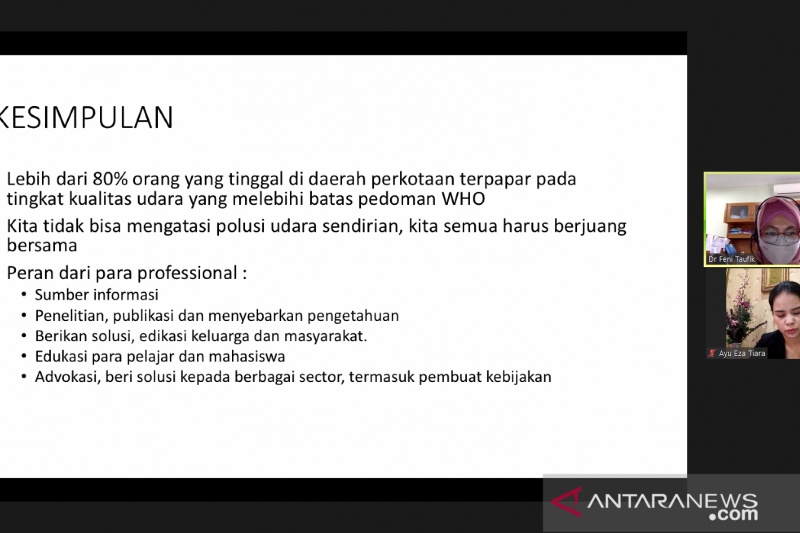Jakarta (ANTARA) – Feni Firtiani Taufik, a pulmonary specialist from the Indonesian Lung Doctors Association (PDPI), said that bad air pollution can increase the risk of symptoms due to COVID-19, especially for those with chronic diseases.
“Air pollution can worsen symptoms of those with respiratory infections, increase the risk of being treated, and the risk of death,” said Feni in an online discussion monitored from Jakarta, Tuesday.
According to him, before the COVID-19 pandemic, bad air pollution or exceeding the threshold had an impact on health, both in the short and long term.
On the short-term side, poor air quality can cause mucosal irritation; red eyes, runny nose, sneezing, upper and lower respiratory tract irritation, increased ARI, asthma, and heart attacks, to increased emergency room visits due to respiration or heart.
Also read: Dirty air worsens COVID, Beta variant is more deadly than the original
Also read: Expert: Quality fuel reduces air pollution
While long-term effects can cause decreased lung function, bronchial hyperreactivity, allergic reactions to asthma, chronic obstructive pulmonary disease (COPD), heart disease, and the risk of cancer.
The existence of the COVID-19 pandemic which also attacks the respiratory side will further worsen the patient’s situation, especially for those who already have chronic symptoms. The risk of being treated and death becomes higher if not treated immediately.
“Air pollution reduces the body’s defense function and respiratory function to fight viruses or bacteria that interfere with health,” he said.
The Ministry of Environment and Forestry (KLHK) sets a limit of PM2.5 fine dust particles in 24 hours of 55 micrograms per m3. The figure is smaller when compared to the set threshold of 25 micrograms per m3 in 24 hours.
Greenpeace Climate and Energy Campaigner Bondan Andriyanu summarized daily data on the PM2.5 quality standard for DKI Jakarta from 1 June to 5 August. In June, the average ambient air quality standard (BMUA) was below the quality standard or below 55 micrograms per M3.
However, when entering July, BMUA above 55 micrograms m3 increased sharply or the status of being in an unhealthy air condition was more dominant. According to him, if the air condition continues to be above the BMUA rate, it will greatly affect vulnerable groups of people (elderly / have comorbid).
“So why is the BMUA low in June because of the high rainfall compared to the Emergency PPKM (July), allowing the washing of particles in the air (when it rains),” he said.*
Also read: World Environment Day, a moment for citizens of the energy transition capital
Also read: Doctors warn of the bad effects of air pollution during a pandemic
Reporter: Asep Firmansyah
Editor: Erafzon Saptiyulda AS
COPYRIGHT © ANTARA 2021
–


